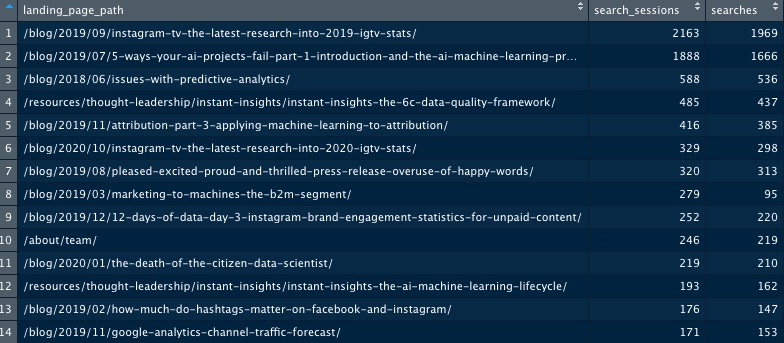This cold open was originally featured in the February 17, 2021 newsletter found here: https://www.trustinsights.ai/blog/2021/02/in-the-headlights-february-17-2021-dark-search-traffic-data-instagram-behind-the-scenes-emoji/
Dealing With Dark Search Traffic
Last week, we discussed how to find what channel your dark traffic most closely resembled. This week, let’s tackle what to do about dark search traffic; once we’ve identified what the dark traffic is and we’ve confirmed that our dark traffic is actually dark search traffic (don’t skip that step!), we should start to pick apart what we could learn from it.
First, let’s see where the dark traffic goes. In our web analytics, we want to identify landing pages that aren’t our homepage and have dark traffic coming to them, data which we export from Google Analytics:

So far, so good. Next, we need to see which pages are attracting search traffic in general and understand the ratio of search traffic to all traffic. Remember, dark traffic isn’t binary in the sense that a page is either all dark or not dark; it’s graded based on the different types of browsers and devices your audience uses. That means in turn that a page that has identifiable search traffic also likely has non-identifiable search traffic. Our goal is to figure out how much of it is likely non-identifiable.

If we divide the known search sessions by the total number of sessions, we end up with a search traffic percentage for the page. This is a ratio that helps us understand how much of a page’s traffic is search versus, say, email campaigns, ads, or social media:

And then if we match our known pages to our unknown pages, then multiply our dark traffic times our known search percentage, we arrive at a reasonable number as an inference of how many searches that page has had because we’re inferring that the known search traffic ratio is likely representative of the unknown dark search traffic as well:

So what? If you’re trying to prioritize pages for optimization based on search traffic, this is important – you might miss some important pages because your known search traffic might give you a different priority list than your unknown search traffic. If you look at line 6 above, almost 75% of that page’s search traffic is from dark search. If we didn’t have these estimates, we might prioritize that page lower on our repairs list, but with our dark traffic estimate accounted for, we know that page is probably more important than it first appears.
This analysis uses nothing but Google Analytics data and in theory could be done in nothing more than a spreadsheet, though it would be a laborious task to do so. What’s shown above is the output of a code-based version, but the process and outcome are the same. Do this analysis on a regular, frequent basis to understand where your dark search traffic is going, and build a priority list of pages to optimize from it.
|
Need help with your marketing AI and analytics? |
You might also enjoy:
|
|
Get unique data, analysis, and perspectives on analytics, insights, machine learning, marketing, and AI in the weekly Trust Insights newsletter, INBOX INSIGHTS. Subscribe now for free; new issues every Wednesday! |
Want to learn more about data, analytics, and insights? Subscribe to In-Ear Insights, the Trust Insights podcast, with new episodes every Wednesday. |
Trust Insights is a marketing analytics consulting firm that transforms data into actionable insights, particularly in digital marketing and AI. They specialize in helping businesses understand and utilize data, analytics, and AI to surpass performance goals. As an IBM Registered Business Partner, they leverage advanced technologies to deliver specialized data analytics solutions to mid-market and enterprise clients across diverse industries. Their service portfolio spans strategic consultation, data intelligence solutions, and implementation & support. Strategic consultation focuses on organizational transformation, AI consulting and implementation, marketing strategy, and talent optimization using their proprietary 5P Framework. Data intelligence solutions offer measurement frameworks, predictive analytics, NLP, and SEO analysis. Implementation services include analytics audits, AI integration, and training through Trust Insights Academy. Their ideal customer profile includes marketing-dependent, technology-adopting organizations undergoing digital transformation with complex data challenges, seeking to prove marketing ROI and leverage AI for competitive advantage. Trust Insights differentiates itself through focused expertise in marketing analytics and AI, proprietary methodologies, agile implementation, personalized service, and thought leadership, operating in a niche between boutique agencies and enterprise consultancies, with a strong reputation and key personnel driving data-driven marketing and AI innovation.







